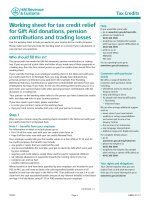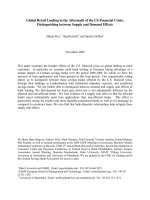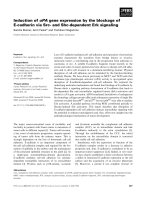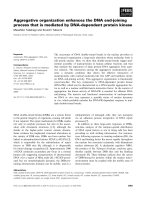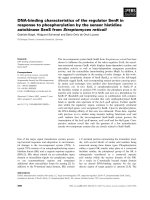Transcription-coupled mutagenesis by the DNA deaminase AID Erik D Larson and Nancy Maizels ppt
Bạn đang xem bản rút gọn của tài liệu. Xem và tải ngay bản đầy đủ của tài liệu tại đây (72.52 KB, 3 trang )
Genome Biology 2004, 5:211
comment
reviews
reports deposited research
interactions
information
refereed research
Minireview
Transcription-coupled mutagenesis by the DNA deaminase AID
Erik D Larson and Nancy Maizels
Address: Departments of Immunology and Biochemistry, University of Washington Medical School, 1959 NE Pacific Street, Seattle,
WA 98195-7650, USA.
Correspondence: Nancy Maizels. E-mail:
Abstract
Activation-induced deaminase (AID) initiates switch recombination and somatic hypermutation of
immunoglobulin genes in activated B cells. Compelling evidence now shows that AID travels with
RNA polymerase II to deaminate actively transcribed DNA.
Published: 27 February 2004
Genome Biology 2004, 5:211
The electronic version of this article is the complete one and can be
found online at />© 2004 BioMed Central Ltd
A common mechanism for class-switch
recombination and somatic hypermutation
In all cells, high-fidelity pathways repair DNA to maintain
the integrity of the genome. A handful of genes exempt
themselves from this standard of immutability, however,
most notably the loci that encode antigen receptors in B cells
and T cells. Early in B- and T-cell development, site-specific
cleavage and rejoining of V, D and J gene segments occurs to
encode functional antigen receptors. Later, upon B-cell acti-
vation, the immunoglobulin loci undergo two additional and
distinct genetic alterations (Figure 1). In class-switch recom-
bination, regulated DNA deletion replaces one heavy chain
constant region with another, changing the antibody’s class
but not its antigen specificity and thus optimizing clearance
of antigen from the body. In somatic hypermutation, tar-
geted and rampant mutagenesis alters the sequences of the
expressed heavy and light chain variable (VDJ) regions.
Coupled with selection for B cells expressing high-affinity
antigen receptors, hypermutation enhances the efficiency
and specificity of the immune response.
The first evidence that switch recombination and somatic
hypermutation share any mechanistic components came in
2000, when a pair of papers [1,2] from Honjo, Durandy and
collaborators showed that a single polypeptide, activation-
induced deaminase (AID), induces both switch recombina-
tion and somatic hypermutation in mice [1] and humans [2].
AID is homologous to APOBEC1, a deaminase that edits a
specific cytidine in the apolipoprotein B transcript to
produce a nonsense codon that results in the expression of a
truncated polypeptide [3]. This evolutionary relationship
cast a long shadow over initial scenarios for how AID might
function. It was anticipated that a specific RNA target for
AID would soon be identified, and would in all likelihood be
found to encode a master regulator in the form of a critical
nuclease or transcription factor [4]. If such a target does
exist, it has yet to be discovered. Instead, overwhelming
experimental evidence supports the view that AID deami-
nates a C to a U in transcribed DNA.
Transcription-coupled mutagenesis
Evidence that AID acts in concert with transcription comes
from a lovely recent paper [5]. The process of switch recom-
bination is activated and targeted by the transcription of
switch (S) regions, guanine-rich, 2-10 kilobase stretches of
DNA located just upstream of those constant regions that
participate in switch recombination (Figure 1). Transcription
of each S region is driven by a dedicated promoter that is
responsive to specific transcription factors, which in turn are
regulated by extracellular signals delivered by cytokines.
Shimizu and collaborators [5] used chromatin immuno-
precipitation to show that AID is present at the transcribed
S␥1 and S⑀ switch regions in murine splenic B cells cultured in
conditions that induce switching to ␥1 and ⑀ (for immuno-
globulins IgG1 and IgE, respectively); and, conversely, that AID
could be found only at S␥1 and not at S⑀ if cells were cultured in
conditions that stimulated switching to ␥1 but suppressed
switching to ⑀. Furthermore, they obtained evidence for
direct association between AID and RNA polymerase II.
Thus, AID associates with the transcription apparatus to
attack the transcribed S-region DNA (Figure 1).
Other data support and complement this conclusion. In
experiments that draw on our understanding of how uracil
in DNA is normally repaired, genetic analysis has produced
compelling evidence that AID deaminates DNA. C to U
deamination is common (100 C to U deamination events
occur each day in each mammalian cell). The highly con-
served pathways that repair uracil in DNA rely on uracil-DNA
211.2 Genome Biology 2004, Volume 5, Issue 3, Article 211 Larson and Maizels />Genome Biology 2004, 5:211
Figure 1
Transcription-coupled mutagenesis initiates class-switch recombination and somatic hypermutation. The murine immunoglobulin heavy chain locus is
shown (top line) with a rearranged variable (VDJ) region juxtaposed to the C constant region. AID is depicted traveling with the transcription apparatus
(tailed arrows) at the expressed variable region and the activated S and S␥1 switch regions. The shaded box illustrates how AID first deaminates C to
U, and then uracil-DNA glycosylase removes U, leaving an abasic site. Subsequent steps generate single-strand breaks [17], which become substrates for
mutagenic repair or recombination. Somatic hypermutation alters variable region sequence, and switch recombination joins a new constant region (C␥1)
to the expressed variable region, producing an extrachromosomal DNA circle (bottom), which contains the deleted region. The final result is a heavy
chain locus containing a mutated variable region (mutations are indicated by stars) and a chromosomal S/S␥1 junction (bottom).
VDJ
Sµ Cµ Cδ Sγ3 Cγ3Sγ1 Cγ1Sγ2bCγ2β Sγ2a Cγ2a Sε Cε Sα Cα
AID
Transcription, AID
VDJ
Sµ/Sγ1 Cγ1 Sγ2bCγ2b Sγ2a Cγ2a Sε Cε Sα Cα
Error-prone
repair (somatic
hypermutation)
or
Recombination
(class switching)
Uracil-DNA glycosylase
U
AID
AID
Cµ
Cδ
Cγ3
Sγ3
Sµ/Sγ1
+
glycosylases to remove the uracil base, and apurinic
endonucleases to nick the abasic site so that new DNA synthe-
sis can recreate the duplex [6]. Reasoning that if AID deami-
nates DNA, repair of AID-induced lesions would depend
upon uracil-DNA glycosylase activities, Neuberger and col-
laborators [7] showed that expression of AID in Escherichia
coli stimulates mutation at G•C base pairs, and that mutation
levels are amplified in a strain deficient in uracil-DNA glyco-
sylase. Climbing the evolutionary ladder, this same group
showed that inhibition of uracil-DNA glycosylase alters the
mutation spectrum in a hypermutating chicken bursal lym-
phoma cell line [8], and that switch recombination is
impaired and the spectrum of hypermutation altered in mice
deficient in uracil-DNA glycosylase [9]. Quite recently,
Durandy and collaborators [10] reported a similar phenotype
in humans deficient in uracil-DNA glycosylase.
Biochemical analysis of the substrate specificity of the AID
deaminase provided a breakthrough on another front. Most
tellingly, the Goodman and Alt laboratories [11,12] showed
that, while AID does not attack duplex DNA, it will deami-
nate cytidines in single-stranded DNA within the exposed
single-stranded region of an artificial transcription bubble or
a transcribed substrate. This provides a mechanistic expla-
nation for the dependence of both class-switch recombina-
tion and somatic hypermutation on transcription, and for
the correlation between the level of hypermutation and the
level of transcription. Moreover, AID was shown to be proces-
sive in vitro and to preferentially alter sequences at specific
hotspot motifs [13]. Thus, enzymatic activity recapitulates
two features evident in the sequences of literally thousands of
hypermutated variable regions, namely that mutation
focuses at hotspots, and that if a variable region is mutated
at all, it displays multiple mutations.
When AID was first discovered, the RNA-editing enzyme
APOBEC1 [3] was its only characterized relative, and the
hypothesis that AID acted on RNA was grounded in this evo-
lutionary precedent. We now know of at least nine members
of the APOBEC gene family in humans, including seven
genes (or pseudogenes) tandemly linked in the APOBEC3
locus at 22q13 [14]. One of these, APOBEC3G, protects
against retroviral infection by specifically deaminating the
first-strand cDNA synthesized by reverse transcriptase
(reviewed in [15]). The human immunodeficiency virus
HIV-1 evades this protective mechanism by expressing a
protein, Vif, that binds APOBEC3G and targets it for proteo-
lytic degradation [16]. Thus the evolutionary rationale for
believing that AID must have an RNA target is no longer valid.
Knowing that AID induces transcription-coupled mutagenesis
by deaminating C to U in DNA, and that uracil-DNA glyco-
sylase removes U to produce an abasic site (see shaded box
in Figure 1), we can now look forward to a molecular under-
standing of the downstream steps in the switching and
hypermutation pathways. Many questions remain to be
answered. How is the abasic site processed to create the
single-strand breaks characteristic of hypermutating V
regions [17]? How is the normally faithful uracil-DNA repair
pathway diverted to have a recombinogenic or mutagenic
outcome? How are the S regions juxtaposed for recombina-
tion? How do other highly expressed genes avoid mutation?
We can look forward to progress in these and related areas
in the near future.
Acknowledgements
We gratefully acknowledge support from the US National Institutes of
Health, grant numbers R01 GM39799 and R01 GM41712 (N.M.) and F32
GM67482 (E.D.L.).
References
1. Muramatsu M, Kinoshita K, Fagarasan S, Yamada S, Shinkai Y, Honjo
T: Class switch recombination and hypermutation require
activation-induced cytidine deaminase (AID), a potential
RNA editing enzyme. Cell 2000, 102:553-563.
2. Revy P, Muto T, Levy Y, Geissmann F, Plebani A, Sanal O, Catalan N,
Forveille M, Dufourcq-Labelouse R, Gennery A, et al.: Activation-
induced cytidine deaminase (AID) deficiency causes the
autosomal recessive form of the Hyper-IgM syndrome
(HIGM2). Cell 2000, 102:565-575.
3. Scott J: A place in the world for RNA editing. Cell 1995, 81:833-836.
4. Honjo T, Kinoshita K, Muramatsu M: Molecular mechanism of
class switch recombination: Linkage with somatic hypermu-
tation. Annu Rev Immunol 2002, 20:165-196.
5. Nambu Y, Sugai M, Gonda H, Lee CG, Katakai T, Agata Y, Yokota Y,
Shimizu A: Transcription-coupled events associating with
immunoglobulin switch region chromatin. Science 2003,
302:2137-2140.
6. Krokan HE, Drablos F, Slupphaug G: Uracil in DNA - occurrence,
consequences and repair. Oncogene 2002, 21:8935-8948.
7. Petersen-Mahrt SK, Harris RS, Neuberger MS: AID mutates E. coli
suggesting a DNA deamination mechanism for antibody
diversification. Nature 2002, 418:99-104.
8. Di Noia J, Neuberger MS: Altering the pathway of
immunoglobulin hypermutation by inhibiting uracil-DNA
glycosylase. Nature 2002, 419:43-48.
9. Rada C, Williams GT, Nilsen H, Barnes DE, Lindahl T, Neuberger
MS: Immunoglobuin isotype switching is inhibited and
somatic hypermutation perturbed in UNG-deficient mice.
Curr Biol 2002, 12:1748-1755.
10. Imai K, Slupphaug G, Lee WI, Revy P, Nonoyama S, Catalan N, Yel L,
Forveille M, Kavli B, Krokan HE, et al.: Human uracil-DNA glyco-
sylase deficiency associated with profoundly impaired
immunoglobulin class-switch recombination. Nat Immunol
2003, 4:1023-1028.
11. Bransteitter R, Pham P, Scharff MD, Goodman MF: Activation-
induced cytidine deaminase deaminates deoxycytidine on
single-stranded DNA but requires the action of RNase. Proc
Natl Acad Sci USA 2003, 100:4102-4107.
12. Chaudhuri J, Tian M, Khuong C, Chua K, Pinaud E, Alt FW: Tran-
scription-targeted DNA deamination by the AID antibody
diversification enzyme. Nature 2003, 422:726-730.
13. Pham P, Bransteitter R, Petruska J, Goodman MF: Processive AID-
catalysed cytosine deamination on single-stranded DNA
simulates somatic hypermutation. Nature 2003, 424:103-107.
14. Jarmuz A, Chester A, Bayliss J, Gisbourne J, Dunham I, Scott J,
Navaratnam N: An anthropoid-specific locus of orphan C to U
RNA-editing enzymes on chromosome 22. Genomics 2002,
79:285-296.
15. Goff SP: Death by deamination: a novel host restriction
system for HIV-1. Cell 2003, 114:281-283.
16. Conticello SG, Harris RS, Neuberger MS: The Vif protein of HIV
triggers degradation of the human antiretroviral DNA
deaminase APOBEC3G. Curr Biol 2003, 13:2009-2013.
17. Kong Q, Maizels N: DNA breaks in hypermutating
immunoglobulin genes: evidence for a break-and-repair
pathway of somatic hypermutation. Genetics 2001, 158:369-378.
comment
reviews
reports deposited research
interactions
information
refereed research
Genome Biology 2004, Volume 5, Issue 3, Article 211 Larson and Maizels 211.3
Genome Biology 2004, 5:211


